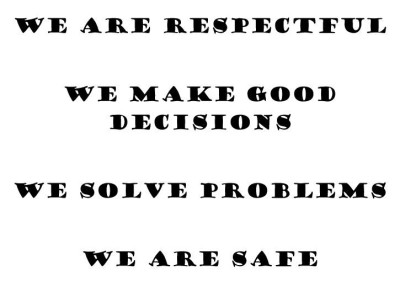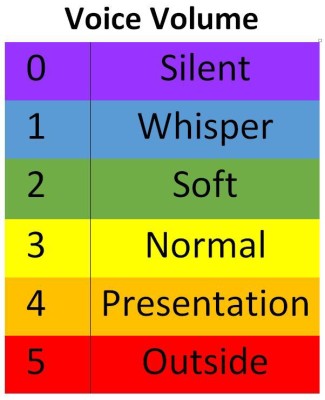This year my district adopted Positive Behavior Intervention and Supports (PBIS), so our teachers got several days of training. In August I attended an unpaid PD day, mostly as a show of support for my new principal. (Remember my article last year “TPEP Is Killing My Principal”? He resigned in the spring. He’s now working for a small private school—and looking a lot more relaxed.) We had a second day of training right before school started and a third in September.
The feds recommend PBIS on their site (http://www2.ed.gov/policy/gen/guid/school-discipline/index.html). One goal of the Department of Education is to decrease expulsions and suspensions. After all, students who are out of school for discipline issues are not likely to make academic gains while they are gone.
On one hand, PBIS focuses on teaching and modeling correct behaviors and offering tons of positive support. On the other, it mirrors RTI in that it helps schools identify Tier I, II, and III level behavior and the types of interventions appropriate at each level.
My class helped make videos of how to behave on the playground, in line, and even at the sinks outside the bathrooms. They love watching themselves show off how to do things right! Our school now has common expectations for the halls, lunchroom, recess, cafeteria—with the entire staff is using the same language, from the four expectations to the numbered noise levels.
Unfortunately, this year we are struggling with a number of Tier III students. So far PBIS isn’t a magic solution for those students.
Our principal, counselor, and interventionist are dealing with emergencies all day, every day. Experienced, seasoned teachers are strained and strung out. Teachers that last year I encouraged to go out for National Boards are equally strained and strung out. As much as we want to fix everything immediately, it’s impossible to effect big, systemic changes overnight.
Under PBIS, my classroom is both a time-out space for students to write reflection sheets, and it’s a haven for emergency evacuations. Late in September, while I was working with my math group, I looked up and realized there was a bunch of “littles” in my room. The dozen second graders had entered so quietly I hadn’t noticed! They were sitting crossed legged in the front of the classroom, hidden by the big fifth grader desks. Their teacher had sent them to my room for safety.
I peeked my head out the door. Three administrators stood there, observing one small student. The administrators said it wasn’t safe to bring my class through the hall to lunch. I had to find another solution, for them and for the second graders suddenly in my care.
How can we solve the problem at our school? We’ve met with district administration and our union president. Multiple district administrators have spent extended time at our building. We’ve received extra support in terms of additional trained personnel. We are working on problem-solving every way we can.
Meanwhile, I’m trying to do small things that might make appreciable differences.
I have one little guy who is a frequent flyer in my classroom. Call him Greg. He comes in often to fill out a Time to Reflect sheet. He’s not very cooperative. He’ll knock over a chair or make rude noises.
But I saw him in the office with an ice pack a couple weeks ago or so. I said, “Oh, honey, what happened?” He told me he hurt his eye. I said I was so sorry and gave him a hug. He melted into me. The principal gave me a surprised look—that was not his normal interaction with adults. But she said, “Good for you, Jan.”
A few days later I saw him in the office again. I said, “Hey, Greg, how’s it going?” It turns out he’d earned a reward and was in the office to collect. I told him how proud I was of him and gave him another hug. He clung to me again.
Now whenever I have a few extra minutes I stop by Greg’s classroom. I kneel by his chair. I ask him to read to me or show me what he’s writing. (His teacher is delighted that I’m giving him this extra support—I did check!)
This week when I said, “See you later,” Greg said, “No.” Surprised, I asked if he didn’t want me to come by any more. It turns out he didn’t want me to leave.
Ok, Greg is not a Tier III kid. He’s a Tier II. But he’s the one hard-to-manage kid who’s frequented my classroom. And if I can be one more adult building one more positive relationship with one more kid in my school, it can’t hurt.
And I also bring brownies for the staff room.


Pingback: Teaching More than Academics—Much More | Stories From School
I just read another great post that addresses this issue, so good as we come into conference time.
https://www.washingtonpost.com/news/answer-sheet/wp/2014/11/14/teacher-to-parents-about-that-kid-the-one-who-hits-disrupts-and-influences-your-kid/
Great post, Jan. It’s interesting that I’ve also noticed an increase this year in “undesirable behavior.” Other teachers in other schools report the same thing. Hmm.
Thank you. I’m the parent of several autistic kids rather like Greg. So your kindness is appreciated. We homeschool because many instructors we’ve encountered – particularly in the younger grades – have been hostile and/or inept. They use the BIST system in our district (paddling was even in the student handbook until recently) and it’s extremely confrontational. More than once one of my older children has been locked in a closet and my younger child was “lost” because he wanders. We have come to realise that many of the “undesireable behaviours” are actually the result of anxiety. (PS my children are not the violent sort, and I didn’t get the idea that “Greg” was, either. He just needs more support and reinforcement.)